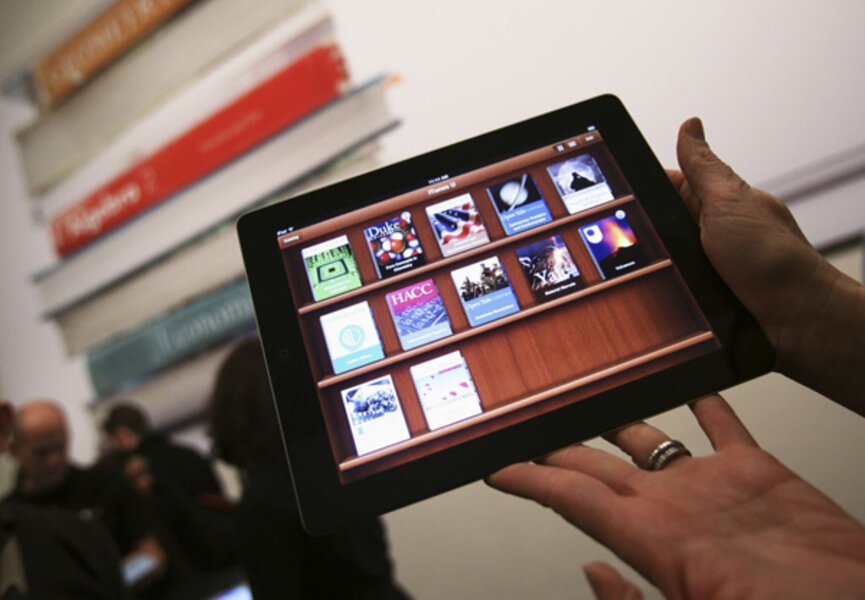iPads and YouTube: Are digital tools in classrooms a student asset or distraction?
Loading...
For a new report, the Pew Internet Project surveyed and held focus groups with more than 2,000 middle and high school teachers in the Advanced Placement (AP) and National Writing Project (NWP) communities and found that 77 percent feel “the Internet and digital search tools have had a ‘mostly positive’ impact on their students’ research habits, but 87 percent say these technologies are creating an ‘easily distracted generation with short attention spans’.”
Almost two-thirds of the teachers (64 percent) said today’s digital technologies ‘do more to distract students than to help them academically’.”
Many of the teachers surveyed are probably amazing educators – like the ones Matt Richtel of the New York Times interviewed for his coverage of the study: Hope Molina-Porter, who has taught for 14 years and cares enough about her students to adjust to changing conditions, and 4th-grade teacher Dave Mendell, who said “it was tougher to engage students, but that once they were engaged, they were just as able to solve problems and be creative as they had been in the past.”
But do stop and think about this data. Thankfully, Mr. Richtel did. High up in the article, he wrote that researchers pointed out their findings represent subjective views and that “scholars who study the role of media in society say no long-term studies have been done that adequately show how and if student attention span has changed because of the use of digital technology.”
But there’s so much more to think about, and I hope that, out of respect for our children, parents and educators will give this even more thought. Here are a few more things I think we need to think about, whether or not you agree with me….
So students are changing. Is this a bad thing? We’re all changing, and a lot of things around us are changing too, not just technology.
As for technology, it’s apparently rewiring our brain. The thing is, it always has – since the beginning of time, at least since Socrates, who “started what may have been the first technology scare,” author Jonah Lehrer wrote in the New York Times, referring to the invention of the book.
And our brains are constantly being rewired by all kinds of things, not just technology. “Being online does change your brain, but so does making a cup of tea,” wrote University of Sheffield researcher Tom Stafford at BBC.com.
What hasn’t changed as much as us and our technology is school. So here’s a thought: How about adjusting teaching and school to our changing students, culture, workplace, and society instead of somehow dialing students back to the way our generation learned (in school)?
Do we really want to make our children conform to the way students used to be – to the way we used to be? I imagine a lot of adults do want that. But we adults were information consumers and memorizers. They are information hunter-gatherers (as media professor Henry Jenkins put it years ago) who don’t need to memorize anything (it’s all at their fingertips 24/7).
What they need more than anything is to learn how to filter that information, to glean what’s of value. Thankfully, the Pew study indicates teachers really get that part: “Overall, the vast majority of these teachers say a top priority in today’s classrooms should be teaching students how to ‘judge the quality of online information’,” but I hope not just online information!
What students will tell you is that a lot of the information presented at school doesn’t interest them.
Students may have been saying this for generations, but what’s different now is that they are awash in information that is of great interest to them outside of school, and it’s instantly accessible (except at school, if they haven’t gotten around the filtering with their cellphones).
We didn’t have that choice. We could dream about what we’d do in our futures, but today’s students can write code, publish an e-book, produce videos, develop a following, get professional coaching, teach guitar on YouTube, take a Web-based MIT class, collaborate on projects, join fellow activists, etc. – whenever they want. That has to make it even harder for them than it was for us to sit through Algebra 2.
Possible conflict of interest? Many teachers – particularly those focused on long-standing measures of academic performance (e.g., AP teachers) – are invested in the education status quo.
So I wonder about the value of polling people about something that threatens the status quo. To her credit, referring to the teachers surveyed, the Pew report’s lead author, Kristen Purcell, said “the label of distraction is a judgment of this generation,” Richtel reported, and “acknowledged that the findings could be viewed from another perspective: that the education system must adjust to better accommodate the way students learn,” which was brought up by some teachers in focus groups.
And media use is just “entertainment”?! I find this really disturbing and disrespectful of students. One teacher asks in the Times piece, “What’s going to happen when they don’t have constant entertainment?” That’s a question a lot of adults have, I know, but it’s based on the mistaken assumption that what media was to us when we were young is what today’s media is to our children. That’s simply not the case.
And yet a whole study – a second survey of educators the Times covers, by Common Sense Media, uses the term “entertainment media” throughout, and respondents were asked questions using that term rather than the more neutral term “media” or “digital media,” prejudicing responses.
For Finding No. 1, Common Sense reports, “When asked about a range of specific academic skills, teachers are much more likely to say entertainment media have hurt rather than helped those skills.”
Virtually all media were included in the study’s definition of the term – including apps, computer programs, social network sites, videos, and texting. Like you, probably, I use all of those in my work. Certainly sometimes for entertainment too, but how is it respectful to assume the same media that is a blend of work and play for adults is just entertainment for youth? A past much-publicized study of theirs represented children largely as media "consumers."
Some improvements actually cited. And credit goes to teachers who saw positive signs amid the “entertainment media” use.
The Times reported that “the surveys include some findings that appear contradictory. In the Common Sense report, for instance, some teachers said that even as they saw attention spans wane, students were improving in subjects like math, science and reading,” the Times reported.
So there we have plenty on teachers’ views. Clearly we need more research on students.’ I hope that’s in the works.
Related links
- Another expert calling on schools to change: In PsychologyToday.com, California State University psychology professor Larry Rosen wrote that “the new, realistic technologies and how they lead to a strong sense of ‘presence’ which can be used to engage young learners. It is not a coincidence that most children’s movies are being shown in 3-D. iGeners are the most technologically immersed generation and just watching the intense look on their faces as they play video games, text all day long, Skype, Facebook, watch YouTube videos, and juggle a dozen websites at a time, it is clear that they are engaged. Now, we need to rewire education to take the home iGen lifestyle and transfer it into the classroom.”
- And in this blog post, teacher Ben Grey asks, “Why does there remain such a fascination with teaching kids very specific technology skills in our schools today?” That would be the new “shop class,” right, Ben?
- “An open letter to tech-fearing teachers everywhere” indicates that some teachers have the misconception that they’re under pressure to teach students technology. That’s not it at all. Students use technology to discuss, present, collaborate on, summarize, do research for, get quizzed on what they’re learning, and that’s only a small sampler of tech’s uses in classrooms.
- “WoWing Language Arts” in The Journal about the breadth of learning students are experiencing in World of Warcraft in school – learning folklore through literature (e.g., Beowulf), vocabulary, socialization, time management, leadership and digital literacy – facilitated by teacher Peggy Sheehy at Suffern Middle School in New York (she elaborates in a video on page 26 of the article).
- The Australia-based Massively Minecraft Guild: “a learning community for kids and their parents [that's] exploring how to live, work and play in Minecraft,” a digital environment game where people individually or collaboratively use LEGO-like virtual blocks to build just about anything they can imagine. It can be either a creative or a survival game with monsters that come out at night. As of this writing, its makers say that “so far 42,098,3157 people have registered and 7,531,314 people bought the game,” with someone new registering about every second, apparently.
- A collective of educators – “GAME” (for Gamers Advancing Meaningful Education) – talk about their work in a new series of Webinars on YouTube, “It Takes a Guild,” starting here. Part two of the series, with teacher Marianne Malmstrom in New Jersey, is here.
- How BYOT (or BYOD), as in technology in the service of learning, works in a Georgia school district.
- Minecraft in School – a video of students’ work from a class developed by instructional technology coordinator Lucas Gillispie and teacher Craig Lawson in North Carolina, who have been collaborating with teacher Peggy Sheehy in New York on creating spaces in Minecraft and World of Warcraft for students to experience both so-called formal learning and informal learning (including social literacy).
- About a highly publicized 2010 study of children’s media use.
The Christian Science Monitor has assembled a diverse group of the best family and parenting bloggers out there. Our contributing and guest bloggers are not employed or directed by the Monitor, and the views expressed are the bloggers' own, as is responsibility for the content of their blogs. Anne Collier is editor of NetFamilyNews.org, a blog, RSS feed, and e-mail newsletter that focuses on "kid-tech news for parents.”








